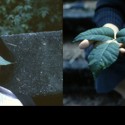I have been thinking that my relationship to nature is too easy, too casual. I have, there fore, decided to befriend a very special plant. Toxicodendron, the plant is better known as poison ivy. Despite its reputation, poison ivy provides shelter and food to insects, birds, and mammals. I am intrigued by the strength of this life form and its resistance to human attempts to control, manipulate or manage it.
I expected poison ivy to reflect a mean emotion. The more I learned about the plant, the more I realized it had no meanness or hateful feelings. Toxicodendron is mysterious. Homoeopathists use it for rheumatism, ringworm and other skin disorders, and they consider it to be one of the most useful remedies*. The Japanese uses Toxicodendron to produce a lacquer called Urushi. The Golden Pavillion (Kinkaku0ji Temple) in Kyoto, is undercoated with black Urushi paint. Its surface has the smoothness and texture that is perfect for the application of gold leaf. I asked Dr. John Rawlins, and entomologist at the Carnegie Museum of Natural History, about the relationship between insects and poison ivy. He said,
“We have three species of moths here in Western Pennsylvania that ONLY FEED ON THE LEAVES OF POISON IVY. Specifically, they are Eutelia pulcherrima , Marathysa basalis , and Paectes oculatrix .”
Poison ivy reminds me to respect nature. Human are a part of nature, but nature doesn’t benefit only humans. Toxicodendron is common in urban landscapes. I noticed that people often don’t know much about common things. I would like to spend time with common plants and creatures which people don’t know much about. Someday, I would like to live closer to their world than to our human world.


